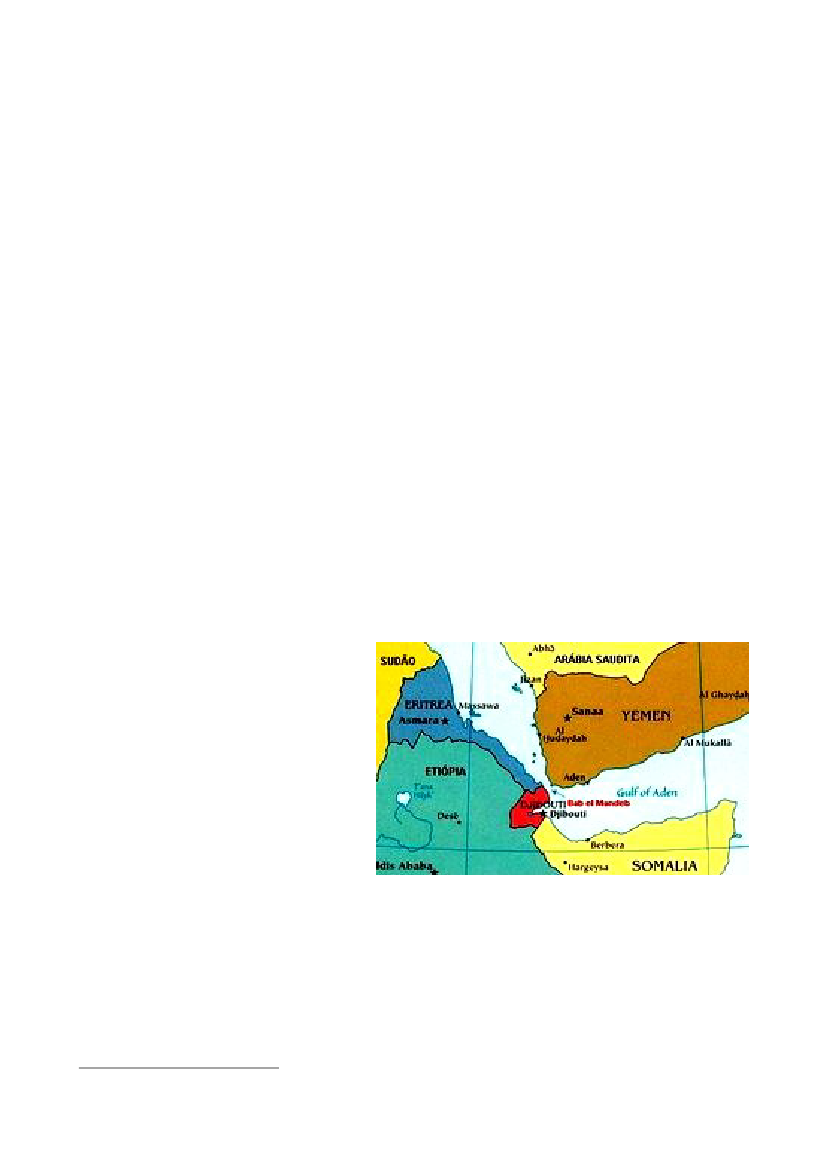NATO's Parlamentariske Forsamling 2010-11 (1. samling)
NPA Alm.del Bilag 5
Offentligt
POLITICAL221 PCTR 10 E rev. 1Original: English
NATO Parliamentary Assembly
SUB-COMMITTEE ONTRANSATLANTIC RELATIONS
SECURITY IN THE GULF AND THE ARABIANPENINSULA: AN AGENDA FOR NATO
REPORT
MIKEROSS (UNITEDSTATES)RAPPORTEUR
International Secretariat
14 November 2010
Assembly documents are available on its website, http://www.nato-pa.int
221 PCTR 10 E rev. 1
i
TABLE OF CONTENTS
I.II.III.
INTRODUCTION.........................................................................................................1THE STRATEGIC IMPORTANCE OF THE REGION .................................................1SECURITY CHALLENGES IN THE GULF AND IN THE ARABIAN PENINSULAREGION ......................................................................................................................2A. PIRACY ..............................................................................................................2B. TERRORISM ......................................................................................................3C. YEMEN ...............................................................................................................4D. IRAQ ...................................................................................................................5E. IRAN ...................................................................................................................6THE ROLE OF THE GULF CO-ORDINATION COUNCIL (GCC) ...............................8NATO IN THE REGION ..............................................................................................9CONCLUSIONS ........................................................................................................10
IV.V.VI.
221 PCTR 10 E rev. 1
ii
Source: The University of Texas at Austin - http://www.lib.utexas.edu/maps/asia.html
221 PCTR 10 E rev. 1
1
I.
INTRODUCTION
1.The security of the Gulf and the Arabian Peninsula is of strategic importance to the Alliance.However, the region’s volatile security situation raises significant concern among the Allies and theinternational community. The instability of Iraq and Yemen, Iran, the continuing threat posed byinternationally active terrorist groups as well as the piracy off the Horn of Africa are factors thatcontribute to the challenging security situation.2.This paper assesses the current political and security environment in the Gulf and theArabian Peninsula and briefly illustrates NATO’s current role in the Gulf, particularly the Istanbul1Co-operation Initiative (ICI) . Your Rapporteur makes some suggestions on how the Alliancecould increase its contribution to the security of the region and concludes that an enlarged NATOapproach and presence in the Gulf should be based upon shared interests and mutual trust with afocus on diplomacy, security co-operation and co-ordination with Gulf State actors.
II.
THE STRATEGIC IMPORTANCE OF THE REGION
3.Abundant energy resources and their geographic location as a hub for international businessand shipping make the Gulf and the Arabian Peninsula of strategic importance to NATO. The Gulfholds approximately 60% of the world’s proven oil and about 45% of its natural gas reserves. TheEuropean Allies currently import approximately 20% of their energy from the Gulf, a figure which ispredicted to increase to 45% by 2030. The US imports roughly 17% of its oil from the region.Japan, a “Global Partner for NATO”, heavily depends on Middle Eastern energy resources as doesChina which is already the largest energy importer from the region. The strategic significance ofthe region will increase, not least because of the region's vital role in the world economy.According to estimates by the International Energy Agency (IEA), the world’s primary energyneeds are expected to grow by 55% between 2005 and 2030.4.The strategic relevance of theregion also derives from its function as ahub for transportation. According to theInternational Navigation Authority (INA),10% of all international trade movesthrough the region. The Strait of Hormuzin the Gulf and the Bab al-Mandab whichconnects the Red Sea with the Gulf ofAden are two pivotal waterways for thetransport of energy. A substantial part ofglobal oil exports, approximately 3.3million barrels of oil per day (MMbd),pass through the Gulf of Aden. At itsnarrowest point, the Bab al-Mandab(Source : http://www.eoearth.org/article/Bab_el-Mandeb)strait, the Gulf of Aden is only 28km wide.Similarly, the Strait of Hormuz, which facilitates 40% of the global seaborne oil trade and all of theGulf’s liquefied natural gas (LNG) exports, is only 50km wide at its narrowest point.
1
Bahrain, Qatar, Kuwait and the United Arab Emirates
221 PCTR 10 E rev. 1
2
III.
SECURITY CHALLENGES IN THE GULF AND THE ARABIAN PENINSULAREGION
5.The region also suffers from continued instability and the countries in the Gulf and theArabian Peninsula face a host of security challenges, including domestic and internationalterrorism, continuing instability in Yemen and Iraq, piracy, as well as Iran’s nuclear programmeand its foreign and security policy stance. While the report focuses on the security issues whereNATO as an organisation can contribute, it is important to briefly list the non-military challenges inthe region.6.Moreover, demographic, economic and environmental problems loom large on the agenda ofthe international community. Problems concerning the access to food, water and energy; a risingpopulation; structural economic deficiencies and inflation, all require a comprehensive approach toGulf security, as they risk damaging the social contract that link State and society in the GulfStates. Gulf countries are under significant pressure to generate jobs in the coming decades due2to rapid population growth and lack of employment opportunities. In addition, current rates ofwelfare spending and redistributive mechanisms are untenable and will require a reassessment ofthe social contract. This could however pose a serious challenge to regime legitimacy, given thatthe provision of public goods is seen in these countries as a right of citizenship.7.Water tables are falling throughout the region, as demand from rapidly urbanising andindustrialising populations exceeds supply from fossil water and local aquifers. Pockets of energyscarcity and reliance on imported natural gas have already emerged, as resources are notdispersed equally in the region. This will of course have a decisive effect on the future regionaldevelopment and prospective sources of tension and insecurity. Based on 2006 production rates,it is estimated that Bahrain, Oman and Yemen will exhaust their oil reserves by 2025.8.Current State capacity to meet increasing demand for services, health, education andemployment is overstretched; the region has been badly affected by the simultaneous blow ofplunging oil prices and the global economic crisis and many development plans are in jeopardy.The existence of large numbers of migrant workers with no civil or political rights and very feweconomic rights is a further source of human insecurity and a potential threat to Gulf States.Whereas they are suffering from rising domestic unemployment, ongoing dependence onexpatriate labour can only lead to significant tension in the future. Gulf States are particularlythreatened by the consequences of climate change due to coastal patterns of settlement. Islandssuch as Bahrain (whose highest point is only 122m above sea level) would naturally be affected byany change in sea levels.
A.
PIRACY
9.The Gulf of Aden has become the world piracy hotspot with 37% of all attacks reported in2008. This area is a critical sea-lane through which 12% of the world’s oil traffic passes each year.According to the International Chamber of Commerce Commercial Crime Services, the number ofpiracy attacks in 2009 was considerably higher than 2008. Somali Pirates are now collectingransom payments of millions of dollars and concern lies in the potential for them to become agentsof international terrorist networks. The money from ransoms is already used to fund the war inSomalia as well as support the Al-Shabaab militant terrorist group.2
The Population Reference Bureau estimates that Gulf Co-operation Council (GCC) populations will increase by42-80% in each country until 2050, and by 151% in Yemen. Its statistics for 2008 also show a large youth bulgeas the proportion of the population under 24 varies from 19% in the United Arab Emirates and 24% in Kuwait to38% in Saudi Arabia and 45% in Yemen.http://www.prb.org/Datafinder/Geography/MultiCompare.aspx?variables=30�ions=
221 PCTR 10 E rev. 1
3
10. The danger and cost of piracy (insurance premiums for the Gulf of Aden have increasedtenfold and since the onset of the upsurge in Somali piracy while the shipping industry has lostUS$ 13-15 billion annually) mean that shipping could be forced to avoid the Gulf of Aden/SuezCanal and divert around the Cape of Good Hope. This would considerably increase the costs ofmanufactured goods and oil from Asia and the Middle East. The sharp increase in piracy in theregion has led to an unprecedented international naval presence off the Horn of Africa, involving agreat variety of actors. In addition to three multinational operations – the US-led CTF 151, EUNAVFOR–Atalanta and NATO’s Ocean Shield – currently deployed in the region, several othernavies are also present. Japan, which adopted a new Anti-Piracy Measures Law in July 2009 thatbroadens the mandate and powers of Japanese ships engaged in counter-piracy operations,maintains two vessels and two maritime patrol aircrafts in the region. Russian ships have beenpresent in the region since October 2008 and both the Russian Federation and NATO haveexpressed willingness to consider stepping up their co-operation in counter-piracy efforts.Moreover, the Chinese Navy is also present in the area since December 2008. This was the firstoverseas deployment of the Chinese Navy for an active operation. Although tactical co-ordinationbetween the different national and multinational deployments has already been greatly enhanced,3there is still room for further improvements .
B.
TERRORISM
11. Terrorist groups, including al-Qaeda, continue to pose serious threats to the countries of theGulf and the Arabian Peninsula. Al-Qaeda has reconstituted some of its operational capabilities,particularly in Yemen. Believed to be widely immune to the threat, terrorism even came home tothe United Arab Emirates (UAE) in early 2009 when authorities quietly broke up a majoral-Qaeda-affiliated terrorist ring that had plotted to blow up symbolic targets in Dubai, like theDubai Towers.12. Following a wave of attacks in 2003 by al-Qaeda on the Arabian Peninsula (AQAP) againstthe House of Saud and Western installations, the Saudi Interior Minister and counter-terroristofficials assumed an aggressive stance and were largely effective in shutting down theorganisation’s operations in Saudi Arabia. However, the Saudi success in countering AQAP ledthe organisation to relocate its operations to Yemen, where they could capitalise upon the weakstate structures. With 3,000km of sea coast, difficult desert and mountain terrain, access to theBab al-Mandab waterway, and the only country from which oil can reach the open seas withoutpassing through either the Strait of Hormuz or the Suez Canal, Yemen offered a strategicsafe haven for al-Qaeda, the wider Salafi-Jihad movement and organised criminal networks.Following the merger of AQAP and al-Qaeda in Yemen, Yemen has become the new centre ofgravity for al-Qaeda in the Arabian Peninsula. Moreover, according to media reports, AQAP wasstrengthened by al-Qaeda fighters from Pakistan and Afghanistan seeking safe havens in Yemenand Somalia.13. Saudi Arabia was embroiled into a conflict between Houthi rebels in North Yemen and thecountry’s government in late 2009, after the rebels crossed into Saudi Arabia and seized Sauditerritory, including some strategically important points. This triggered the largest Saudi militaryoperation since Iraq invaded Kuwait in 1990. While a ceasefire has now been agreed, thesituation continues to be fragile and tensions remain.
3
For more detailed information, see the excellent report of Lord Joplin for the Committee on the Civil Dimension ofSecurity: “The Growing Threat of Piracy to Regional and Global Security” [169 CDS 09 E rev. 1]
221 PCTR 10 E rev. 1
4
C.
YEMEN
14. The failed bombing of Northwest Airlines flight 253 thrust Yemen into the internationalspotlight in December 2009. The country is facing a host of problems, including the threat posedby al-Qaeda, a Houthi rebellion in the North and a secessionist movement in the South. Yemen,the poorest State in the Arab world, is in dire economic conditions. More than half of thepopulation live in poverty; unemployment is estimated at around 35%; about 50% of the populationis illiterate. Yemen’s birth rate is one of the highest in the world; its population is expected todouble by 2030, almost two thirds of the approximately 23 million inhabitants are younger than25 years; the country is also grappling with dwindling water resources, generated by lack of watermanagement and climate change. Moreover, an estimated 40% of groundwater is used forcultivation of the “qat” drug. Farmers continue to use more and more water in production of thehighly profitable crop. Seventy-five percent of the population still lives in rural areas, but watershortages will lead to a significant increase of Internally Displaced Persons (IDPs). Yemen hasfew natural resources other than oil. However, oil production, which accounts for nearly 80% ofgovernment revenue, is anticipated to run out in a decade, thus further limiting the ability of thecountry to tackle the many problems it faces. The central government is weak and its inefficientpolicies have aggravated some of the existing problems. Government control of the countrycontinues to erode and is limited to the major highland cities in the northern part of the country.15. Yemen runs the risk of becoming a breeding ground for terrorism and a haven forextremists. AQAP has initiated attacks both in and from Yemen. Islamist fighters are returningfrom Iraq and Afghanistan; in 2009 approximately one third of the prisoners in Guantanamo werefrom the country. The deteriorating security situation in Yemen could destabilise the whole regionand gravely aggravate existing challenges already posed by piracy, organised crime and Islamistextremism, with serious implications for the internal security of Yemen's neighbours. To combatterrorism Yemen needs assistance in equipment and training for its security forces.16. Perhaps even more importantly, the country needs a long-term development strategy forinfrastructure development as well as education, and health. In late January 2010, the LondonConference which established the “Friends of Yemen” group bringing together more than20 Western and Arab countries to devise a collective strategy toward Yemen is a step in the rightdirection. However, the pledges made now have to be implemented. At an earlier donors’conference in 2006, the international community now have pledged US$ 5.7 billion, but only someUS$ 250 million of that amount have been transferred thus far. One of the main reasons for thedelay has been the rampant corruption in the country. Tribes continue to be predominant politicalplayers in the country. The unification of the country in 1990 and the clear victory of the Northover the South in the 1994 civil war have consolidated the hold of Yemen’s predominantlyNorthern tribes over State resources. Yemen’s military and security apparatuses have come toreflect tribal interests.17. While security and terrorism are serious challenges to the country, the fight againstal-Qaeda elements must be part of a larger strategy. Foreign assistance is crucial to help buildState capacity, improve governance and fight rampant corruption in the country. The assistancemust be well co-ordinated and coherent, focusing on a long-term development, economic andpolitical reform agenda. Therefore, Western governments need to work towards an effectiveregional approach with the Member States of the Gulf Co-operation Council, in particular SaudiArabia and the UAE, which are key for the stabilisation of Yemen. NATO as an organisationshould monitor the situation and encourage its partners in the region through various consultationmechanisms to adopt a proactive approach.
221 PCTR 10 E rev. 1
5
D.
IRAQ
18. The developments in Iraq also have an important impact on the stability of the region.Overall violence in Iraq has dropped significantly and security has improved greatly during the pasttwo years. However, although Iraq has become safer than it was even a few years ago, it is stillnot a “normal” country even by the standards of security in the Arab world, Kenneth Pollack,Director of Saban Center for Middle East Policy, Brookings Institution, briefed the Sub-Committeein July 2010. There are still many people killed every month by inter-communal violence.Moreover, corruption and organised crime continue to flourish while the country’s infrastructure,particularly water and energy, is still decrepit and dysfunctional as a result of 20 years of damageand neglect. Extremist groups which have become more fragmented and mobile, continue tooperate in the country. There are also tensions between Sunnis and Shias, as well as disputesbetween Arabs and Kurds. The de-Ba’athification process remains a bone of contention whichcould still wreck the reconciliation among the ethnic groups. Therefore, Iraq is “absolutely notsolved”, Mr Pollack noted, adding that there is a real chance that the country could slide back intoa major civil war similar to the one it experienced from 2005 to 2007. Academic studies oninter-communal civil wars have shown that about half of the States that suffered from civil warssimilar to the one in Iraq are very likely to face a re-occurance of conflict, often within five years,the expert pointed out to the Sub-Committee. Moreover, if the country possesses valuable naturalresources like diamonds, gold or oil, the likelihood rises even higher.19. Thus, Iraq remains highly vulnerable to a resurgence of civil war. The new Iraqi governmentwill need to address three crucial issues, namely the relations between the Arabs and the Kurds,including the status of Kirkuk; the normalisation of relations between Iraq and Kuwait; and theeffective management of oil revenues. Unfortunately, at the time of writing, there is still noagreement on a new government following the parliamentary elections in early March 2010.According to Mr Pollack, these elections were a “huge victory for the Iraqi people” who had largelyvoted for the two parties considered most secular, least connected with militias, and least tied tothe vicious sectarianism of the civil war. The vote reflects Iraqis’ overwhelming desire for change,particularly for a representative, transparent government that is responsive to their needs.However, the Sub-Committee learned, not many politicians believe in democracy: if they could,they would go back to the “old bad politics”. There is a great danger in allowing the perception totake hold that the election was “stolen” in the politicking that followed it. The precedents set in thiselection will endure for a long time to come and the international community must pay moreattention to the final outcome of this election.20. On 1 September 2010, the US has formally ended "Operation Iraqi Freedom", the combatoperations in the country. With the transition to "Operation New Dawn”, the US military presencehas been drastically reduced to just under 50,000 soldiers. The remaining US troops focus ontraining Iraqi police, although around 4,500 remaining special forces will still be engaged,alongside Iraqi troops, in operations against al-Qaeda militants. While the US military presencewill expire at the end of next year, the limited capabilities of the Iraqi security forces may convincethe Iraqi government to request a continuation of the US troops beyond that date. Iraq’s securityforces remain heavily dependent on US logistical support, air power, equipment and expertise.Moreover, analysts suggest that continued US military presence may be requested as areassuring presence for Iraqis fearing a revival of sectarian and ethnic bloodshed.
21. International engagement remains essential for the continuation of the normalisation processin Iraq. As the US military presence is winding down, the international community now plays asupportive rather than a leading role in Iraq. The UN will continue to play an important advisoryrole as it was done, together with the US, in the run-up to the election, where their facilitationgenerated the necessary consensus on an election law. Moreover, with the NATO TrainingMission – Iraq (NTM-I) the Alliance is making a meaningful contribution to the stabilisation of the
221 PCTR 10 E rev. 1
6
country. NTM-I has provided training, equipment, and technical assistance to the Iraqi SecurityForces to help Iraq develop an effective, democratically-led and enduring security sector. NTM-I isnow transitioning towards a lean mentoring force supporting an Iraqi-led institutional trainingprogramme. The EU is also assisting Iraq with the integrated EU rule of law mission in Iraq(EUJUST LEX) which has trained over 3,000 Iraqi justice officers since it was established in 2005.On 14 June 2010, the EU Council decided to extend the mandate of the mission.
E.
IRAN
22. Iran’s nuclear programme and its alleged support for terrorist groups represent the mostsignificant security challenge to the region. The government in Tehran has failed to comply fullywith requirements of the International Atomic Energy Agency (IAEA) and continues to defy UNSecurity Council (UNSC) resolutions that demand suspension of its uranium enrichment. Instead,it advances the development of uranium enrichment technology. The discovery of a seconduranium enrichment facility near Qom in September 2009 added to suspicions that Tehran’s realaim is to acquire nuclear weapons technology. In a February 2010 report, the IAEA expressed, forthe first time, fears that Iran may actively pursuing nuclear weapons capability. The report alsonoted that Iran's level of co-operation with the Agency has decreased.23. Over the last years, the international community has tried both persuasion and coercion tomake Iran comply fully with its obligations as party to the Nuclear Non-Proliferation Treaty (NPT).In December 2006, the UN Security Council adopted Resolution 1696, the first of a series ofresolutions imposing sanctions in response to the regime’s non-compliance with IAEAnon-proliferation safeguards and oversight. The US Administration under President Obama haschanged the tone towards Iran, but has not succeeded in engaging Iran on a broader front. Iranignored the 31 December 2009 deadline to respond to an offer from the “P5 + 1” (the fivepermanent members of the UN Security Council plus Germany) for economic and politicalincentives in exchange for halting its nuclear enrichment programme.24. On 9 June 2010, the UNSC passed a fourth round of sanctions on Iran. UNSC Resolution1929 imposed additional international sanctions on the regime’s nuclear programme and militaryactivities. The resolution also targets Iran’s financial sector and restrains its nuclear proliferationactivity. What is more, several countries have adopted additional national sanctions which targetIran’s economy, particularly affecting trade and energy investment.25. However, even though the new set of sanctions is unprecedented, it is unclear if themeasures will be effective in persuading the regime to comply with the demands of the UNSC.Iran has been targeted by US sanctions for more than 30 years - and by UN sanctions since 2006- and none of these coercive measures has resulted in Tehran giving up its nuclear research.Despite the passage of UNSC Resolution 1929, the permanent UN Security Council members donot necessarily share a unified position on Iran, mainly due to divergent economic and geopoliticalinterests. Iran may also be able to circumvent sanctions, or at least significantly limit their impact.For now, hopes of reaching a diplomatic agreement with Iran on its nuclear programme have beendampened. There is a profound lack of trust on all sides. A strong anti-Western sentiment amongthe political leadership and domestic political developments in Iran are other factors complicatingthe situation. Independent Iran experts, including Kenneth Pollack, consider that the moderateshave lost influence in shaping the country’s policy. The decision-making process remains opaque,but there appears to be a widening rift among conservatives within the ruling establishment. .26. If the regime in Tehran continues to defy the international community, the latter and theAllies might have to choose one of three options to react to the challenge posed by Iran: “regimechange”; a military strike on Iran to destroy its nuclear facilities; or containment.
221 PCTR 10 E rev. 1
7
27. As to the first option, “regime change” could not – and must not – be imposed from outside.Any change in government can only be initiated by the Iranian people themselves. The domesticpolitical situation of Iran is very complex; there is considerable dissatisfaction, particularly amongthe younger generation. The government of Mahmut Ahmedinejad faces strong criticism over theeconomic situation as well as over human rights. Nonetheless, following the harsh crackdown ondissenters after the contested outcome of the 2009 presidential election, the regime appears fartoo strong and the Green Movement too weak for a “regime change”. That said, the GreenMovement could provide a channel for the dissatisfaction that remains widespread amongIranians.28. On the second option, while not out of the question, your Rapporteur considers theconsequences of a military option to be devastating. An attack would destabilise the region andbeyond; close the Strait of Hormuz; and, if unsuccessful or only partially successful, could result inan acceleration of an Iranian nuclear weapons programme.29. This would appear to leave containment of the Iranian regime as the most viable currentoption. However, the situation is more complex. The Gulf States are already engaged in a majorarms race. The volatile security situation in a number of neighbouring countries and the lack ofsecurity trust create a dangerous situation that need to be addressed by other means.30. The preferred goal remains finding a negotiated solution that would address the securityconcerns of the international community as well as those of Iran and its neighbours. The latter isof particular importance, as Iran’s Arab neighbours are apprehensive over the possibility of agrand bargain between the West and Iran, which could constitute an acknowledgment of Iran’s4pre-eminence in the region. As your Rapporteur has suggested in a previous report , by puttingIran on its political agenda NATO can help building a robust consensus among the Allies andpartners, particularly the ICI participants, over an acceptable regional role for Iran. Putting Iran onNATO’s political agenda could also ensure policy co-ordination among NATO member and partnercountries. Your Rapporteur wants to stress that NATO Secretary General Rasmussen haspointed out that Iran’s increasing ballistic missile capabilities pose a threat to the European Allies.31. Although the Allies and Iranian neighbours perceive Tehran’s nuclear programme as well asits current regional policy as mostly negative and as a threat to the stability and security of theregion, there are also a number of areas where Iran and the West have common interests. Iranplayed a constructive role in the initial success in overturning the Taliban regime in 2001. Iran hasconsiderable influence in Afghanistan, with which it shares a 940km-long common border. Almosthalf of the Afghan population speaks Dari or related Persian dialects. In mid-2010, some950,000 Afghan refugees were registered in Iran, making it the country with the third largestrefugee community worldwide. Iran is strongly engaged economically in Afghanistan and providessignificant development assistance. It can make an important contribution in Afghanistan as it haslong-standing ties with a wide range of powerful regional warlords. Iran is also crucial for thestability of the Gulf; it has considerable influence in post-Saddam Hussein Iraq and it has closeties with Syria and Hamas, both of whom are important players in the Arab-Israeli conflict.Moreover, although Iran does not recognise Israel, reaching agreement with Iran could facilitatesettlement of the Mid-East conflict – which remains the responsibility of the parties involved on thePalestinian, Israeli and Arab sides. The Allies could therefore consider engaging Iran and thecountries of the Gulf in serious and sincere discussions about a range of regional security matters.32. Reaching agreement with Iran would require that the government in Tehran plays aconstructive role. It has been noted that Iran pursues destabilising activities and policies in theregion, particularly in Afghanistan and in Iraq. Moreover, the 2009 Country Reports on Terrorismof the US Department of State, suggests that Iran “remained the most active State sponsor of4
“Iran - Making a Case for NATO's Political Engagement” [166 PCTR 08 E bis]
221 PCTR 10 E rev. 1
8
terrorism” in 2009. According to the report, Iran provides training and weapons for the Taliban aswell as for militants targeting US forces in Iraq and provides safe haven for al-Qaeda members. Itis unclear if destabilising actions result from official Iranian government policy, but Tehran musteither end or decisively act against these security threats.
IV.
THE ROLE OF THE GULF CO-ORDINATION COUNCIL (GCC)
33. An important factor for the stability of the region is the Gulf Co-operation Council, which wasset up in May 1981. It brings together Saudi Arabia, Kuwait, Bahrain, Qatar, the United ArabEmirates and the Sultanate of Oman. Ever since its creation nearly 30 years ago, there havebeen frequent statements about shared challenges and the need for mutual trust. This is howeverin stark contrast with the tangible progress on the economic, political and security levels. AlthoughGCC members have stated their willingness to further deepening their co-operation by announcingthe establishment of a GCC customs union (2003), a common market (2008), a common currency,a Gulf Defence Pact, and an agreement on counter-terrorism co-operation (2004), suchannouncements have often not been implemented effectively.34. Persistent intra-regional disputes (such as the border dispute between Saudi Arabia and theUAE) and fears of Saudi dominance on the part of the smaller States have hindered progresstowards security co-operation, which has lagged behind economic integration. In 1986, a unifiedGCC force based in Saudi Arabia - the "Peninsula Shield"- was set up, but the Council failed toexpand this force whose fate was disputed in the past, mainly because of lack of consensusamong the Gulf States. The GCC States have also been unable to adopt a regional approachtowards Iran and Yemen. The GCC States are also concerned about Tehran’s nuclearprogramme, Iranian aspirations of regional hegemony and some aspects of its foreign policy.Reflecting their security concerns, GCC countries are increasing their expenditure on defence toan estimated US$ 63 billion in 2010, two-thirds of which is covered by Saudi Arabia.35. However, at the same time, the bilateral relations of GCC States with Iran vary. Historically,there is wide mistrust and suspicion between Saudi Arabia and Iran. Both strive to be recognisedas the epicentre of the Islamic world. Saudi Arabia, as well as Bahrain, also claims that Iran ismeddling in its internal affairs and intentionally stirring up their Shia populations. Kuwait hashistorically engaged Iran as a counterweight to Iraq.However, after the removal ofSaddam Hussein, Kuwait has become increasingly suspicious over Iran’s regional ambitions. TheUnited Arab Emirates have territorial disputes with Tehran over the Abu Musa and Greater andLesser Tunb islands. At the same time, Dubai is home to a large Iranian expatriate communityand is greatly influenced by Iranian investment as it handles an estimated 60% of Iran’smerchandise trade and hosts nearly 10,000 Iranian-owned firms. Oman and Qatar view Iran as animportant partner stemming from its proximity and shared sense of history, culture and trade.Oman, which has no sizeable Shiite community, has deepened its relationship with Iran inAugust 2009, when Iranian Foreign Minister Manouchehr Mottaki and Omani Foreign MinisterYusuf Ben Alawi signed a security co-operation agreement. Despite some disputes over sharingthe North Field/South Pars natural gas reserve, Tehran and Qatar have a strong relationship.Qatar was the only country to reject a UNSC resolution calling for Tehran to halt uraniumenrichment.36. The GCC already plays a relevant role for the stability of the region. However, thecapabilities of the GCC could be improved by closer co-operation among the Member States. Forexample, the limited progress in the defence co-operation among GCC Member States hasresulted in redundant capabilities and deficient interoperability. Convincing the GCC states toforego their national interests in favour of coherent GCC security co-operation will be a difficulttask. Political relations are conducted on a personal rather than on an institutional level.Moreover, Gulf States have preferred bilateral consultations and dependence on Western powers
221 PCTR 10 E rev. 1
9
to a more co-operative and multilateral initiative. In the long term, NATO could help should GulfStates decide to identify areas of co-operation and pool together resources. As an advisor, NATOcould pave the way for limited but substantial progress towards integration where each State couldcontribute to an overall and more cost-effective Gulf security system as opposed to pursuingindependent defence agendas.
V.
NATO IN THE REGION
37. Launched at the 2004 NATO Summit in Istanbul, the primary goal of the IstanbulCooperation Initiative is to enhance regional security and stability by providing a forum to promotegreater co-operation between NATO and the Gulf region. To date, Kuwait (December 2004),Bahrain and Qatar (February 2005), and the UAE (June 2005) have joined the Initiative. Similar toNATO’s Partnership for Peace (PfP) programme and NATO’s Mediterranean Dialogue (MD), eachICI Member State can tailor its co-operation with NATO according to its own specific needs andinterests. ICI offers bilateral and tailored advice on defence reform, budgeting, planning, and civil-military relations. Member States can participate in a range of activities, such as military-to-military co-operation, border security exercises, training to counter illegal trafficking and civilemergency planning. There have been numerous tangible achievements of the ICI’s contributionin advancing the defence capabilities and confidence between NATO and the Gulf States.38. ICI originally started off as a bilateral initiative between individual participating Gulf Statesand NATO. While the individual aspect remains important, ICI has further developed into amultilateral event where the ICI countries meet together with NATO Allies. So far, there havebeen three so-called NAC+4 meetings (North Atlantic Council and all four ICI partners). Duringthe most recent meeting in March 2010, the NAC+4 discussed security challenges in the Gulfregion.39. ICI will continue to evolve gradually according to the needs and interests of the Gulfcountries. For example, to deepen existing practical co-operation, NATO and ICI countries coulddiscuss establishing Individual Co-operation Programmes which would allow ICI partners to betterdefine the scope and pace of their co-operation with NATO. At the same time, this would allowNATO to better focus its assistance and support. Bahrain is currently considering whether it wantsto engage in an Individual Co-operation Programme with NATO.40. Moreover, anti-piracy operations in the region provide additional scope for co-operationbetween NATO and ICI partners. NATO is currently conducting Operation Ocean Shield, acounter-piracy operation off the Horn of Africa. Participation of ICI partners in NATO maritimeoperations (be it with ships, logistics, exercises or information sharing) would enhance the securityof shipments through the Gulf of Aden.41. What is more, ICI could be further developed by upgrading the political dialogue to includeregular meetings on ministerial level. This would allow deepening and expanding political andsecurity dialogue between NATO and ICI Member States. To that end, NATO and participating ICIpartner states could agree on a “joint declaration” stating the aims of the Initiative, which wouldform the basis for a truly multilateral approach. Such a joint declaration could also expand ICI toinclude a provision which would allow any active ICI participant to consult with NATO if it perceivesa direct threat to its territorial integrity, political independence, or security.42. NATO Allies and the GCC countries face common security challenges, such as terrorism,the proliferation of weapons of mass destruction, piracy, energy security, and failed States.Moreover, NATO and GCC countries have shared interests, for example the stabilisation ofAfghanistan and Iraq, and preventing countries like Yemen from becoming failed States.Therefore, the participation of all GCC Member States in ICI would not only strongly contribute to
221 PCTR 10 E rev. 1
10
the stability and security of the region, but it could also be used as a tool to advance the GCC asan organisation.43. In addition to the ICI, NATO is engaged in the Gulf region through other mechanisms. Inaccordance with UNSC Resolution 1546, Alliance members have established NATO TrainingMission - Iraq (NTM-I), which seeks to build effective and sustainable multi-ethnic security forcesthat will respect civilian control, international and local laws, and professional standards. NTM-Ioffers mentoring, provides support through in- and out-of-country training and facilitates thedelivery of donated military equipment. Due to NATO’s contribution to rebuilding the militaryleadership of Iraq, in December 2008, on the request of Iraqi Prime Minister Nouri Al-Maliki, NATOexpanded the mission to other areas including navy and air force leadership training, bordersecurity and defence reform and institution building. Moreover, on 26 July 2009, NATO and theGovernment of the Republic of Iraq signed a long-term agreement that provides the legal basis forNATO to continue training Iraqi Security Forces (LTA).44. Finally, particularly through ICI and the NTM-I, NATO already makes a meaningfulcontribution to the security of the region. That said, one must acknowledge that there is a seriouslack of knowledge about the Alliance. Co-operation may also be limited due to a lack of culturaland strategic understanding between the NATO Allies and the countries of the region. If NATOwants to become more effective in the region, and indeed in the whole Middle East, it shoulddevelop and implement a better communication strategy. NATO has already identified publicdiplomacy as a priority area in its dealings with the Arab world, but it has only been able to devisevery little resources to that end. In the view of some, the best starting point for any communicationstrategy would be to establish an Arabic language NATO website, including an Arabic edition ofNATO Review.
VI.
CONCLUSIONS
45. The strategic global importance of the Gulf and the Arabian Peninsula cannot be over-emphasised. The Gulf’s geographic location and the energy resources extracted from andtransported through the region make it pivotal for the world economy. However, the countries ofthe region face a host of security challenges and continuing instability. The Allies and NATO asan organisation therefore need to continue and deepen their engagement with their regionalpartners and those of the GCC in particular.46. Any approach by NATO in the region needs to be pursued through a comprehensive andmultidimensional manner that respects the authority and sovereignty of their Gulf partners, whilecombining military interaction with diplomatic and political engagement. With regards to theregion, NATO should follow a strategy that:Promotes interoperability between the Gulf and NATO as an organisation, and thatoffers an array of educational and training programmes;Further develops the ICI by elevating the political dialogue with ICI countries toministerial level and by passing a joint declaration between NATO and the participatingICI countries which also includes a clause that allows any active ICI participant toconsult with NATO if it perceives a direct threat to its territorial integrity, politicalindependence, or security;Expands membership in the ICI, and utilises this engagement vehicle to developmultilateral relations;Continues assisting Iraqi security forces through NTM-I;Bolsters current maritime co-operation and co-ordination in the Gulf on a regional andinternational level to mitigate the harmful effects of piracy and organised crime;
221 PCTR 10 E rev. 1
11
Engages non-NATO member countries, particularly the Contact Countries (Australia,Japan, New Zealand and South Korea), but also China, Russia and India regardingshared regional interests, pertaining - but not limited to - maritime security andprotecting critical energy infrastructure.
47. While it is beyond the scope of this report to discuss NATO’s stance toward Iran, putting Iranon the political agenda of the Alliance can help building a robust consensus and ensuring policyco-ordination among NATO member countries and their partners. A NATO strategy based uponthe above recommendations will converge with the interests of the Gulf States and effectivelycontribute to long-term security and stability in the Gulf. Without expanding NATO’s engagement,your Rapporteur strongly believes that political upheaval, unsettled territorial disputes, nuclearproliferation, economic uncertainties, and a host of other threats will continue to plague thesecurity of the region and that of the wider international system.
__________________________














